Seeing your aloe plant droop and dull may worry you. An overwatered aloe plant shows clear signs, and knowing them can help you act fast. Let’s dive into how to spot an overwatered aloe and bring it back to health.
I’ll cover the signs of too much water, like soft leaves, brown stems, and moldy soil. You’ll learn how to revive your plant and prevent future issues, ensuring your aloe stays vibrant and healthy.
If your aloe is struggling, don’t lose hope. With the right steps, you can save your plant and keep it thriving. Read on to find out how to care for an overwatered aloe vera plant.
- Related article: Tips to Grow Aloe Plant
7 Key Takeaways on Overwatered Aloe Plant
- Overwatering is a common issue that can lead to serious health problems or even death in aloe vera plants.
- Signs of overwatering include soft, droopy, yellowing leaves, and waterlogged, brown stems.
- Blistering leaves, mold on the soil, and soft, waterlogged roots are clear indicators of excessive moisture.
- To save an overwatered aloe vera plant, remove it from its pot, trim damaged roots, and repot it in well-draining soil.
- Ensure that your pot has drainage holes and use well-draining soil to prevent overwatering issues.
- Adjust your watering frequency based on the plant’s environment, typically watering every 2-3 weeks and reducing during winter.
- Monitoring soil moisture levels and choosing the right pot with proper drainage are crucial for maintaining a healthy aloe vera plant.
Signs of an Overwatered Aloe Vera Plant
Aloe vera plants are easy to take care of, but it’s also easy to overwater them. Look out for these common signs of an overwatered aloe plant:
1. Aloe Vera Leaves Turning Soft, Droopy and Yellowish

The normally firm and upright leaves become soft and limp. Leaves may appear swollen or puffy due to excess water absorption. The characteristic plumpness of healthy aloe leaves gives way to a sagging, drooping appearance.
Overwatered leaves feel mushy or squishy when gently squeezed. The usual crisp, rigid structure of the leaves becomes noticeably softer. In severe cases, the leaf tissue may feel almost gelatinous.
Overwatered leaves might develop a yellowish tinge. The vibrant green color may become duller or paler. Instead of pointing upward or outward, leaves tend to droop downward. The plant’s overall shape becomes less compact and more spread out.
This symptom typically starts with the lower, older leaves and progresses upward. If not addressed, the softness and the droopy leaves can affect the entire plant.
2. Alove Vera Stems Becoming Soft and Turning Brown
Stems may feel mushy or spongy when gently squeezed. In severe cases, the stem’s internal structure can break down completely, leading to a loss of rigidity.
Healthy aloe vera stems are typically green or grayish-green. Overwatering causes the stems to turn brown, often starting from the base. Initially, the browning may appear as spots, then spread across larger areas of the stem.
The softening and browning usually start at the base of the plant near the soil line. These symptoms can gradually move upward if overwatering continues. In advanced stages, the entire stem may become affected.
3. Alove Vera Leaves Blistering
When aloe vera plants are overwatered, small, water-filled blisters appear on the leaves. These clear, raised bumps can vary in size and are typically found on the flat surfaces of the leaves, both upper and lower. They often start on the lower, older leaves but can affect newer growth too.
The blistered areas feel spongy or squishy, with normally firm leaf tissue becoming softer around the blisters. Initially small and scattered, these blisters can increase in size and number with continued overwatering, sometimes merging into larger areas.
5. Soil Not Draining
Soil with a high clay content can retain too much water, making it dense and compact. This type of soil holds water for extended periods, preventing excess moisture from escaping. After watering, water may pool on the surface or take a long time to be absorbed.
Effects on Aloe Vera:
- Root Health – Poor drainage leads to waterlogged soil, suffocating roots by depriving them of oxygen.
- Growth – Aloe vera plants in poorly draining soil often exhibit stunted growth due to inadequate root function.
- Soil Compaction – Over time, soil that doesn’t drain well becomes even more compacted, worsening the problem.
6. Aloe Vera Roots Becoming Soft and Waterlogged
Healthy aloe vera roots are firm and white or light-colored. When overwatered, roots become soft, mushy, and lose their structure. Waterlogged roots often turn brown or black as they begin to rot, and they may emit an unpleasant, musty smell.
Process of Root Deterioration:
- Roots are constantly surrounded by water, depriving them of necessary oxygen.
- Prolonged saturation causes root cells to break down, resulting in a soft, mushy texture.
- Lack of oxygen and cellular breakdown create an environment for fungal and bacterial growth, leading to root rot.
Impact on Plant Function:
- Nutrient Uptake – Soft, waterlogged roots are inefficient at absorbing nutrients from the soil.
- Water Balance – Despite being surrounded by water, the plant may show signs of dehydration as damaged roots can’t effectively transport water.
- Structural Support: Weakened roots provide less anchoring support to the plant.
7. No New Growth After Pruning
Pruning normally stimulates new growth in healthy aloe vera plants, with new leaves or offshoots typically appearing within a few weeks to a couple of months.
Signs of No New Growth:
- No new leaf buds or small leaves emerge from the center of the plant.
- No new offshoots or “pups” forming at the base of the plant.
- The pruned areas remain bare without any signs of regeneration.
If no new growth is observed within 4-6 weeks after pruning, it may indicate a problem. This timeframe can vary depending on growing conditions and the season.
8. Mold on the Soil
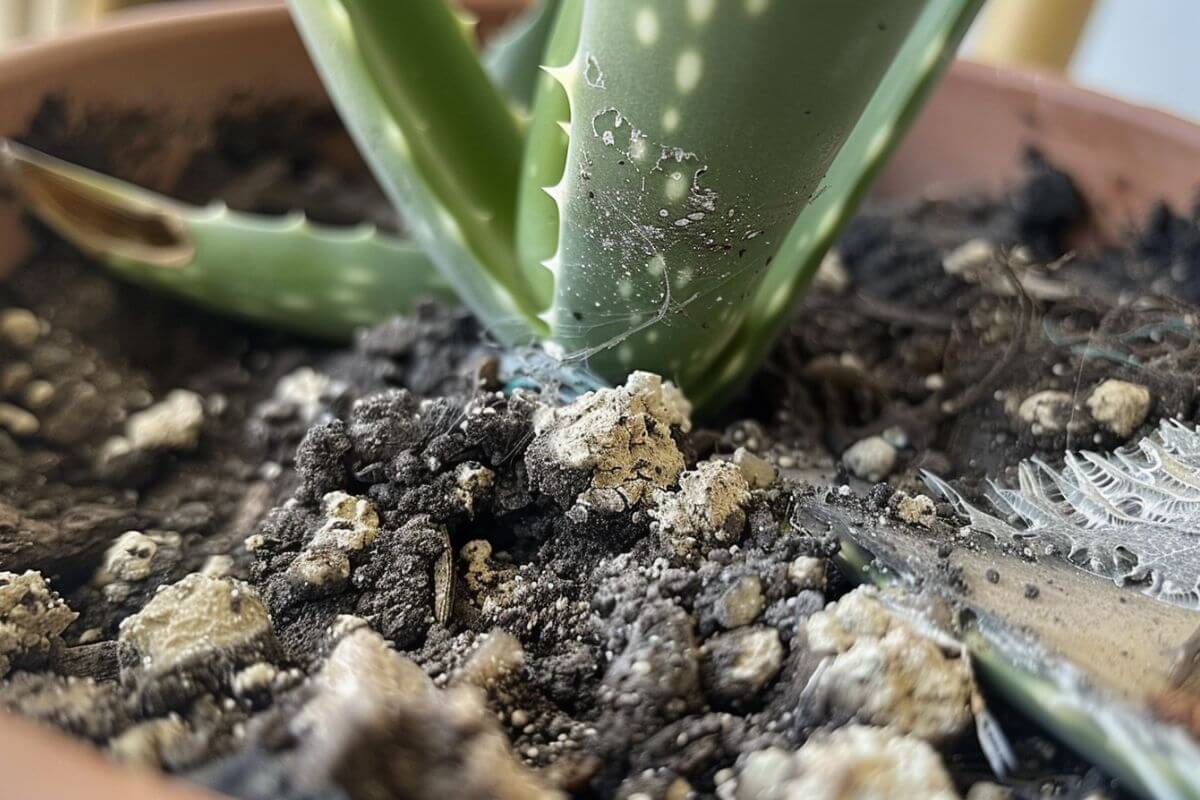
Mold on the soil surface of an aloe vera plant is a clear sign of excessive moisture.
Mold on the soil surface of an aloe vera plant typically appears as white, gray, or greenish fuzzy patches. It often has a powdery or cotton-like texture creating a mushy soil texture. Initially, mold can appear in small spots but may spread across the soil surface if not addressed.
Types of Mold Commonly Found:
- Saprophytic Fungi – The most common type found on houseplant soil.
- Penicillium – Often appears as blue-green patches.
- Aspergillus – Can be various colors, including white, yellow, or green.
Can You Save an Overwatered Aloe Vera Plant?
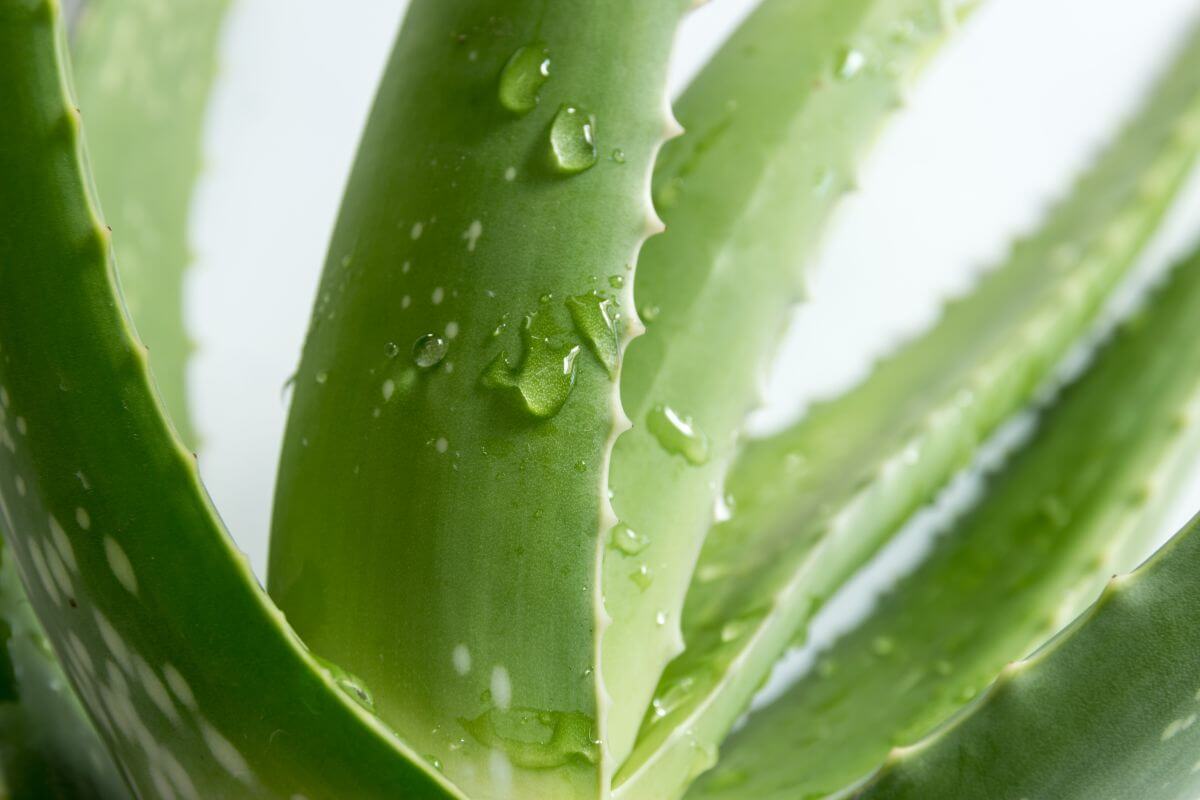
Yes, you can save an overwatered aloe vera plant if you act quickly. Watch for signs of overwatering, such as soft, mushy leaves, and take immediate action.
If the damage isn’t too severe, you can still rescue the plant. If root rot hasn’t spread to all the roots, you can prune the rotted parts and replant the healthy sections.
Aloe vera plants are resilient and worth saving. If you catch the issue early, there’s a good chance your plant will recover.
Recognizing the symptoms early will give you the best chance to revive your overwatered aloe vera.
How to Revive an Overwatered Aloe Vera Plant
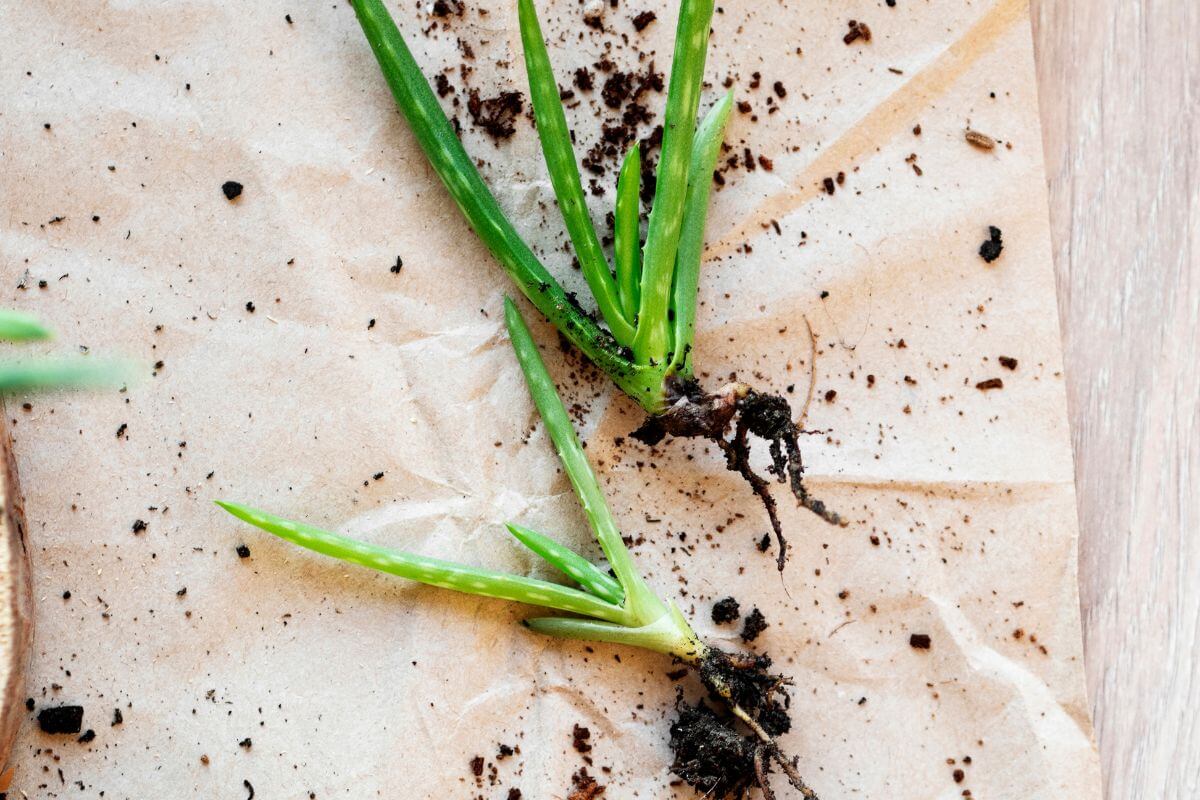
To treat waterlogged soil, you need to dry it out and improve its drainage. One method is to spread the soil on newspaper and let it dry in the sun.
After drying, you can enhance the soil’s drainage by adding sand or perlite. Replacing the potting mix usually resolves most overwatering issues. However, if root rot is present, more work is required.
Root rot is a common problem with overwatering, so I’ll guide you through the steps to revive an aloe vera plant affected by root rot. Here’s how to do it:
- Assess the Damage – Look for signs of root rot, such as mushy, black, or brown roots, foul odor, and yellowing or wilting leaves.
- Remove the Plant from Its Pot – Gently take the aloe vera out of its pot, being careful not to harm the roots further.
- Clean the Roots – Rinse the roots under lukewarm water to remove old soil. This helps you see the damage and prevents pathogens from affecting the plant.
- Trim the Damaged Roots – Use clean, sharp scissors or pruning shears to cut away affected roots. Healthy roots should be white and firm, while damaged ones will be black, brown, or mushy.
- Allow the Plant to Dry – Let the roots air dry for a few hours to a day. This helps prevent further rot and allows cuts to heal.
- Prepare a New Pot with Proper Drainage – Choose a pot with drainage holes to allow excess water to escape. Terracotta or clay pots are ideal as they help with moisture control.
- Use Well-Draining Soil – Fill the pot with a cactus or succulent potting mix, or make your own by mixing regular potting soil with sand or perlite for good drainage.
- Repot the Aloe Vera – Place the aloe vera in the new pot, making sure the base of the leaves sits just above the soil line. Gently pack the soil around the roots for support.
- Adjust Watering Habits – Water sparingly, allowing the soil to dry out completely between waterings. Typically, every 2-3 weeks is sufficient, but adjust based on your climate and environment. Reduce watering during the winter when the plant is dormant.
- Provide Proper Light and Temperature – Place the plant in bright, indirect sunlight. Aloe vera thrives in bright light but can be sensitive to intense direct sunlight. Maintain temperatures between 55-80°F (13-27°C).
- Monitor and Care – Watch the plant for signs of recovery or stress. Healthy new growth indicates the plant is recovering. Avoid fertilizing until you see new growth, as over-fertilizing can stress the plant.
Tips to Prevent Overwatering the Aloe Vera Plant
Preventing and avoiding overwatering of aloe plants will go a long way to keeping your plant healthy. These tips will help prevent overwatering issues.
1. Monitor and Maintain Soil Moisture Levels
Monitoring soil moisture levels helps keep your plants safe from over-watering. The best method is using a soil moisture meter. This device allows you to measure the amount of water present in the layer of soil where the plant roots are.
A free testing method is to use your finger and sticking it into the soil. Feel how wet or dry the soil is and water your aloe plant, if needed.
2. Use Well-Draining Soil
The right soil mix for plants is essential to plant health. It needs to be able to retain enough water for plants to use but also needs to drain the excess water, so the soil doesn’t become soggy.
3. Water from the Bottom
Watering from the bottom will help ensure the aloe plant roots will get water. If you water from the top, the large leaves may stop the water from getting to the soil and to the roots.
4. Frequency of Watering
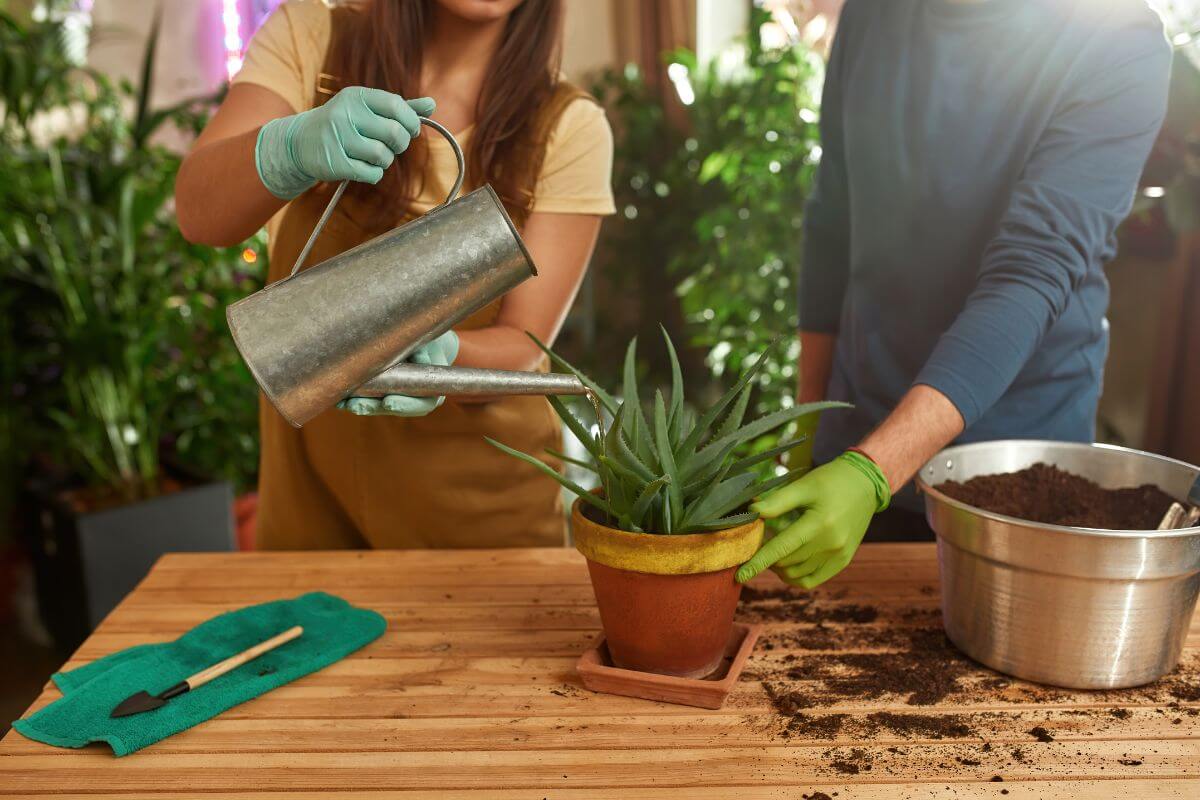
How often you water will affect whether your aloe plant gets too much water or not enough. Watering when the soil isn’t dry yet will lead to overwatering. Use the finger test or a moisture meter to check if water is needed.
After a time, you’ll learn how often you need to water for different seasons. Younger plants will also need more water, so be aware that less frequent watering will be needed as the aloe vera plants mature.
- Learn more Tips on How to Water Aloe Vera
5. Choose the Right Pot – Material and Drainage
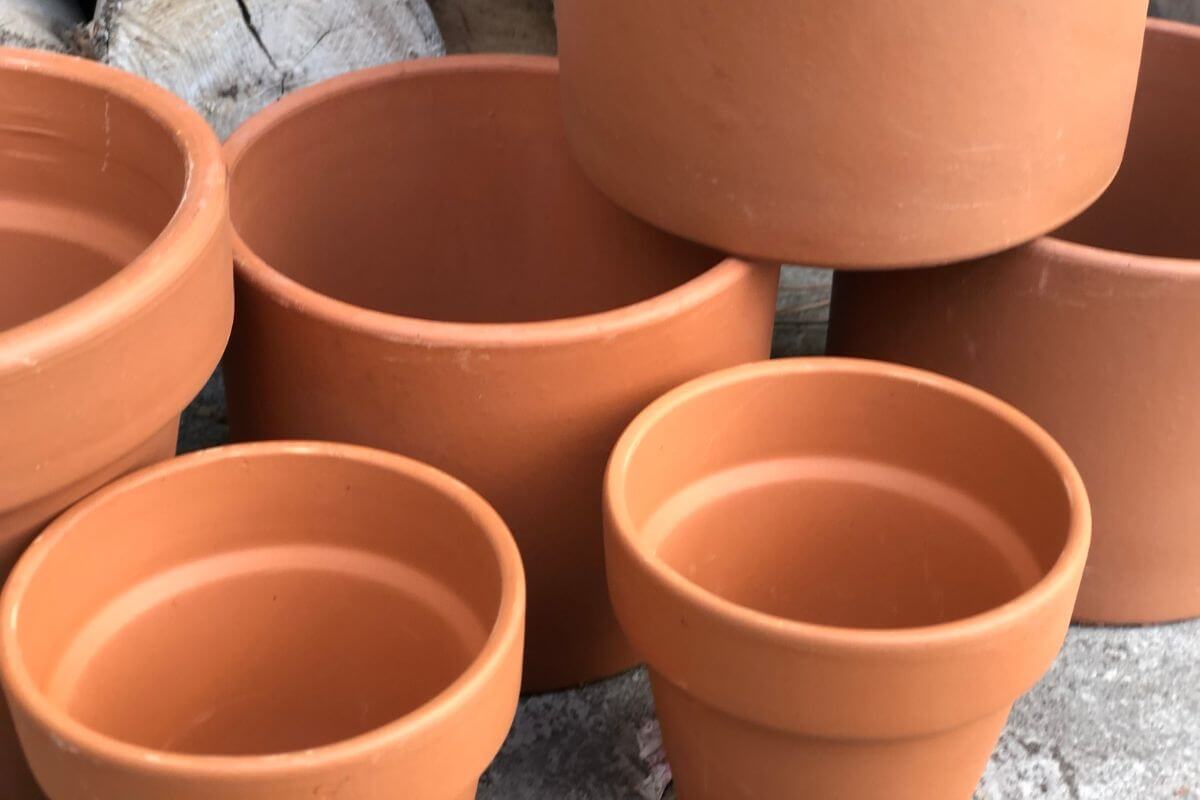
To choose the right pot for an Aloe vera plant, consider both the material and drainage capabilities. Here is a detailed guide:
Terracotta or Clay Pots
- Pros – Porous material allows for better airflow and moisture evaporation, which helps prevent root rot.
- Cons – Heavier and more fragile than other materials.
Ceramic Pots
- Pros – Attractive designs and good insulation for roots.
- Cons – If not properly glazed, they may lack adequate drainage. Ensure they have drainage holes.
Plastic Pots
- Pros – Lightweight, durable, and inexpensive. Retain moisture longer, which is useful in very dry climates.
- Cons – Less breathable, which can lead to water retention issues if overwatered.
Always choose a pot with at least one drainage hole to prevent water from accumulating and causing root rot.
Select a pot that is slightly larger than the root ball. A pot that’s too large can retain excess moisture, while one that’s too small can restrict root growth.
Use a saucer to catch excess water but remember to empty it regularly to prevent water from sitting at the bottom of the pot.
Overwatered Aloe Vera Plant Final Thoughts
Avoiding overwatering an aloe vera plant is key to keeping it healthy, and there are several effective ways to do this. Regularly monitoring your plant’s soil moisture is a simple but powerful method to prevent overwatering.
As you become familiar with your plant’s needs, these practices will become second nature. You’ll find yourself automatically adjusting care and no longer worrying about overwatering. With consistent attention, your aloe vera will thrive.
Overwatered Aloe Vera Plant FAQs
1. What Are the Signs of an Overwatered Aloe Vera Plant?
Overwatered aloe vera plants often show signs like yellowing or browning leaves, soft or mushy leaves, and a rotting smell from the soil. The plant might also have stunted growth or be dropping leaves.
2. How Can I Save an Overwatered Aloe Vera Plant?
To save an overwatered aloe vera plant, first remove it from its pot and check the roots. Trim away any rotten or mushy roots and let the plant dry out before replanting it in fresh, well-draining soil. Ensure the pot has drainage holes and water only when the soil is completely dry.
3. How Often Should I Water My Aloe Vera Plant?
Aloe vera plants should be watered infrequently. Generally, watering every 3-4 weeks is sufficient, allowing the soil to dry out completely between waterings. In winter, reduce watering even further as the plant’s growth slows down.
4. Can Overwatering Cause Root Rot in Aloe Vera Plants?
Yes, overwatering can lead to root rot in aloe vera plants. When the soil is constantly wet, the roots can become waterlogged, leading to rot and fungal infections that can ultimately kill the plant.
5. What Type of Soil Is Best for Aloe Vera Plants to Prevent Overwatering Issues?
Aloe vera plants thrive in well-draining soil. A cactus or succulent mix is ideal because it allows excess water to drain away quickly, preventing waterlogged conditions. You can also mix regular potting soil with perlite or sand to improve drainage.
Here are other articles on aloe vera plants to explore:





